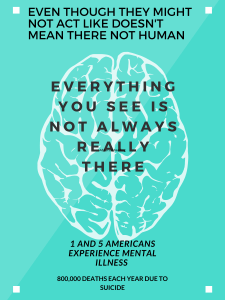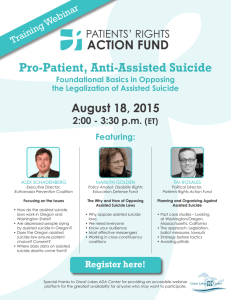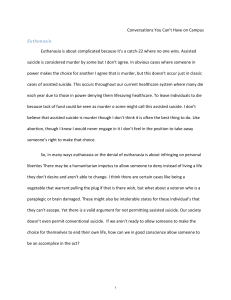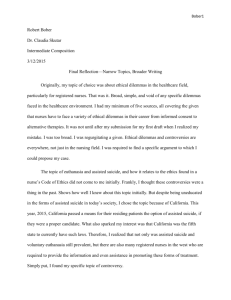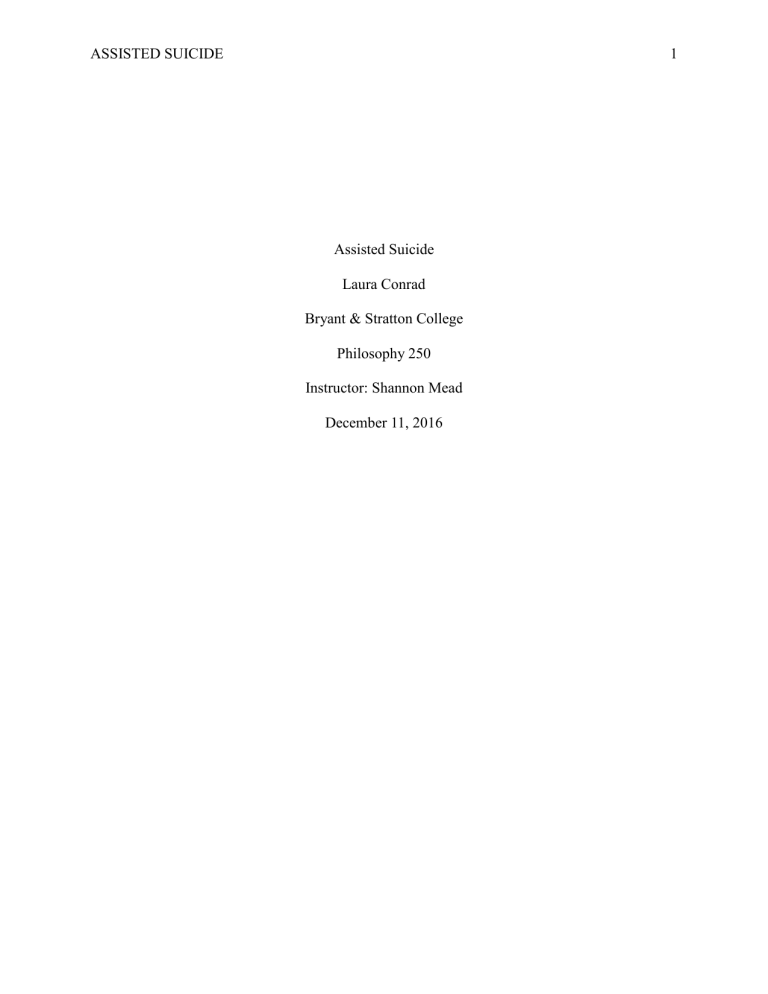
ASSISTED SUICIDE 1 Assisted Suicide Laura Conrad Bryant & Stratton College Philosophy 250 Instructor: Shannon Mead December 11, 2016 ASSISTED SUICIDE 2 Assisted Suicide There are many pros and cons on the topic of Assisted Suicide. Moral, ethical, religion beliefs, and health play a big role in the decision to request a physician to assist in this act. As one of the most worldwide debated topics, in many countries it is illegal and some countries including a few states in the U.S. have legalized it. This topic has been debated for many years since Oregon’s Death with Dignity Act of 1994. Pro’s The list of pros on the topic of assisted suicide is growing. When a patient is diagnosed with a terminal illness or disease they may feel a sense losing control of their life. If given the choice as to when to end their life would allow for patients diagnosed with a serious illness or disease to have control over their own bodies, their own lives, and their future physical/psychosocial distress (Frellick & Charles, 2016). When the disease process is entering the stage of pain, phycological status, and loss of mobility which takes independence away, the option for an individual to choose not to endure such a process can help them become more at ease or peace with their illness. This choice can also help the families or loved ones of these patients ease their grieving process (NYLN,2015). The ability to choose when to die allows loved ones to prepare themselves for the loss verses the pain and grief when someone dies suddenly. Even though loved ones are informed of a terminal illness and understand that person will eventually die, the sudden phone call of a loved one passing or they are actively dying can be hard to deal with. By the time this phone call is passed along to family and friends it is too late for goodbye’s. The choice for assisted suicide can grant family and friends the option to be present to say goodbye or goodbyes can be said prior to the day/time. This will help the patient leave in peace (NYLN,2015). Another pro is assisted suicide would lower medical cost (NYLN,2015). Medical care cost for terminally ill patients can run into the hundreds of thousands. The testing, treatments, and surgeries can put a huge financial strain on the patient, families, and the economy. This not the answer to solving the ever-growing financial burden of medical cost, but it is a benefit for struggling families that are devastated by a diagnosis. Medical cost to care for a terminally ill loved one can put stress on the person themselves especially if that person is the main financial ASSISTED SUICIDE 3 provider for a family. They question themselves as to how they will continue to provide for their family or how finically stable their family will be after they have passed on. This can cause more emotional stress, physical stress, and physiological stress on top of the diagnosis. This can lead the patient to making rash decisions like taking their own life unassisted leaving their family and friends with the grief of a sudden loss. There is a law that gives patients the right to refuse medical treatment of any kind that every state recognizes (Gorsuch, 2006). If a competent patient has the right to tell their physicians to stop any lifesaving treatments including giving food and water, they should be able to ask for assistance in ending their life (Gorsuch, 2006). Ultimately a patient who has refused all lifesaving medical treatments is committing suicide anyway and the suffering they endure can be unbearable. If they had the right to choose for assisted suicide, they would not suffer the pain of dying naturally from an illness. The few states that have legalized assisted suicide have strict guidelines as to who could essentially request assisted suicide. Oregon’s Death with Dignity Act 1944 reads- “Requests for dwda drugs must be confirmed by two witnesses and approved by two doctors. The patient must not be mentally ill. And most important of all, the two doctors must agree that the patient has a maximum of six months to live. Because of this, about two-thirds of all patients who requested drugs had cancer, an illness that frequently has a definite timeline. Only about one-sixth have degenerative diseases with indeterminate timelines, like Alzheimer’s or als—Lou Gehrig’s disease” (Drum, 2016). With these strict guidelines, not just anyone can make a request for assisted suicide. So, the thought that people can just go to the doctor and get something to kill themselves is not valid. In a study conducted at the Department of Medicine, University of Rochester Medical Center in Rochester, New York, it was founded that patients are more interested in the possibility and find comfort in the thought of a back-up, then those in actuality will use the prescription (Frellick & Charles, 2016). Con’s1 In the debate of assisted suicide the cons on the topic are moral, legal, ethical, and religious concerns (NYLN,2015). The moral concerns in assisted suicide are more attributed to religion (Levy, 2014). Many religions strongly forbid the act of suicide and religious healthcare professionals simply refuse to partake in such an act. Catholics state in their funeral mass for someone who has committed suicide the person will live in purgatory and will not cross over to ASSISTED SUICIDE 4 see the face of god. In many countries, it is illegal to assist in the act of suicide and is punishable by law. In Germany, the term “euthanasia” is forbidden due to associations with the Holocaust and anyone who assist in this act is charged with manslaughter with a five-year prison sentence (Levy, 2014). One of the major ethical and legal arguments on assisted suicide is the act of helping someone commit the act goes against the Hippocratic Oath physicians take. The oath considers human life as sacred; therefore, commanding respect. Even with the consent to end one’s life from the patient himself does not make killing right (NYLN,2015). The legal concern in many countries is consent. If assisted suicide is requested is the patient mentally capable of such a request and does the patient have the proper information to make this decision. Then there is the argument of palliative care (Levy, 2014). Physicians and lawmakers who are against assisted suicide argue that palliative care is the better alternative to assisted suicide. Patients receiving treatments for a terminal illness or disease can receive palliative care to keep them comfortable during the end stage of an illness and lets the natural dying process occur (Levy, 2014). In the Netherlands where assisted suicide is legal there is little or nonexistent palliative care (NYLN,2015). The concern is assisted suicide will affect patient who still wish to get better and live a full life due to physician’s not worrying about palliative care because they can suggest assisted suicide (NYLN,2015). Supporting Cases. The legalization of assisted suicide would cut down the rate of people committing unassisted suicide on their own and the rate of depression in those left to grieve such a loss. An example, A retired physician fractured three of his ribs and requested a full work up at the hospital. He was diagnosed with multiple myeloma, cancer of the bone marrow (Drum, 2016). Since he was physician he knew how the rest of his life would play out and he made the decision to end his life when he felt the time was right. His illness progressed and he fell again one night that’s when he decided it was time. He was not going to tell his family of his plan to end his own life, but a friend persuaded him it was the right thing to do. He called his family and the next day with family present he took his own life (Drum, 2016). If this man suffering from a painful cancer had the option of assisted suicide he would could have better prepare his family. Instead of calling them the night before he planned to end his life and causing the family the shock of the sudden phone call to inform them of what his plans were. ASSISTED SUICIDE 5 Another story comes from a woman who was diagnosed with Alzheimer's disease. This woman was aware of the process of this disease and did not want to live a life of not recognizing her family. She decided that at the last possible moment of clarity she had, she would take her own life. Being a physiologist she knew the affects and rates of depression of loved ones left behind when someone commits suicide (Spiegel, 2014). This woman’s daughter was angry at her for making this decision, but when the day her mother had chosen to end her life, she understood her mother’s decision. The woman surrounded by her family and friends had a get together to celebrate her life before she took it. The woman no longer remembered her accomplishments everyone was talking about. Two days later she drank a drink to overdose herself and was gone. Her family states that the way she prepared them for her death helped the grieving process easier (Spiegel, 2014). Conclusion. Having the choice to die with dignity not only helps the patient, but their loved ones as well. With the legal, ethical, and religious beliefs in this debate, someone might ask the non-supporters the question of “What if it were you”? The pros outweigh the negatives in this topic for me. If given the choice would you rather suffer within your diagnosis or ease the pain for yourself and your loved ones? ASSISTED SUICIDE 6 References Drum, K. (2016, Jan-Feb). My Life to Leave (cover story). Mother Jones, 41(1), pp. 26-60. Retrieved Nov 20, 2016, from http://eds.b.ebscohost.com.libproxy.bryantstratton.edu: Frellick, M., & Charles, V. (2016, March 10). The Debate of Physician-Assisted Suicide: The Pros and Cons. Retrieved from Medscape: http://www.medscape.org/viewarticle/859347 Gorsuch, N. M. (2006). The Future of Assisted Suicide and Euthanasia. Princeton, N.J: Princeton University Press. Retrieved Nov 20, 2016, from eds.b.ebscohost.com.libproxy.bryantstratton.edu: Levy, N. (2014, Dec 12). Legal Issues...Assisted Suicide. Ipswich,, Massachusetts, U.S.: CINAHL Nursing Guide EBSCO Publishing. Retrieved Nov 22, 2016, from eds.a.ebscohost.com.libproxy.bryantstratton.edu NYLN. (2015, July 13). Doctor Assisted Suicide Pros and Cons List. NYLN Youth Leader Blog. Retrieved from http://nyln.org/doctor-assisted-suicide-pros-and-cons-list Spiegel, A. (2014, June 23). How A Woman's Plan To Kill Herself Helped Her Family Grieve. Retrieved from http://www.npr.org/sections/health-shots/2014/06/23/323330486/how-awomans-plan-to-kill-herself-helped-her-family-grieve
